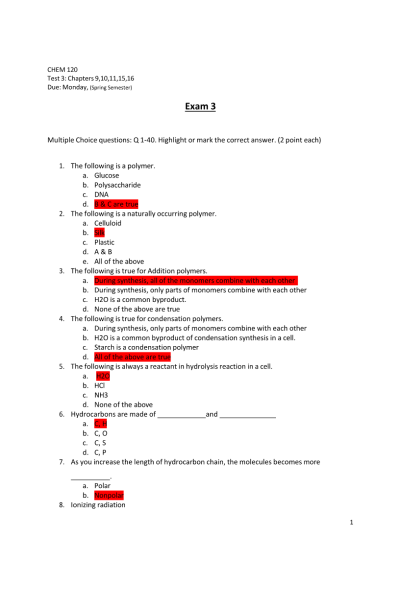Multiple Choice questions: Q 1-40. Highlight or mark the correct answer. (2 point each)
- The following is a polymer.
- The following is a naturally occurring polymer.
- The following is true for Addition polymers.
- The following is true for condensation polymers.
- The following is always a reactant in hydrolysis reaction in a cell.
- Hydrocarbons are made of and
- As you increase the length of hydrocarbon chain, the molecules becomes more
.
- Ionizing radiation
- “Free radicals disrupt cellular processes.” This statement is
- Half-life is defined as
- “Radiation is used as diagnostic and a therapeutic tool in medicine.” This statement is
- Energy is defined as
- The SI unit of energy is
- Exothermic reactions
- Reaction of acid with a base results in product formation with increase in temperature. It is an example of
- “The first law of thermodynamics is also a law of conservation of energy.” This statement is
- An apple hanging on a branch has
- Falling water from a water fall has
- The entropy in nature is
- When Carbon-14 undergoes alfa decay, the product is
- When P-32 undergoes beta decay, the product is
- The following is true for gamma decay.
- A sum of ALL reactions in a cell is called
- Synthetic reactions in the cell are called
- Degradative reactions in the cell are called
- Carbohydrates are made of
- Proteins are made of
- Fats are made of
- is a polysaccharide
- are the catalysts of the cell.
- Lipids are .
- Unsaturated fats contain .
- Animal fats are ; while plant oils contain fats.
- The following is not a component of DNA.
- The following describes a difference between DNA and RNA.
- Match the structural formula with name of the following compounds
- CH3CH2CH2CH2NH2
- CH3OH
- CH3CH2OCH3
- CH3CH2COOCH3
- CH3CH2F
| Instituition / Term | |
| Term | Summer |
| Institution | Chamberlain |
| Contributor | Karin Austin |





-80x80.JPG)



-80x80.JPG)









































